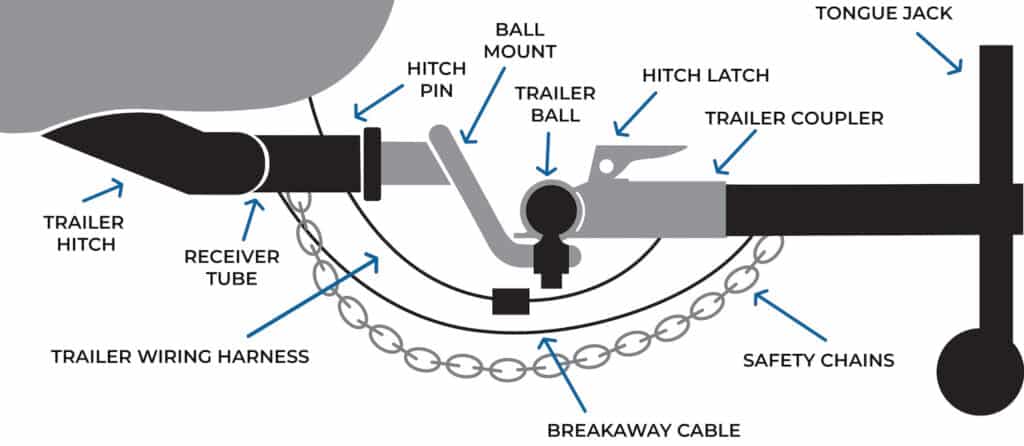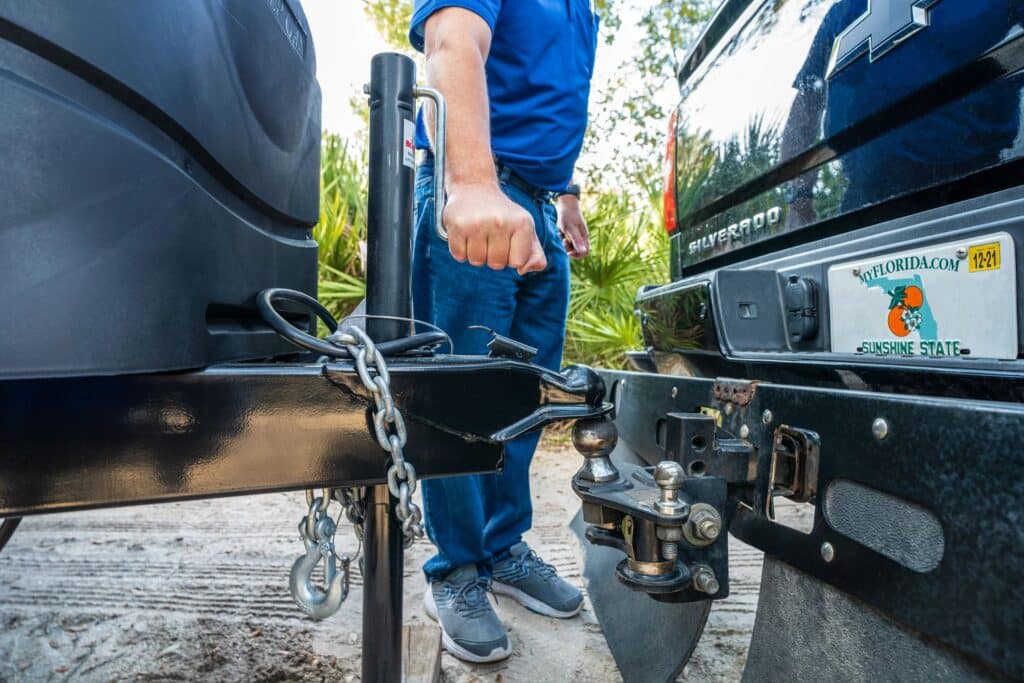Towing a travel trailer takes a little getting used to when you’re new to it. It all starts with learning how to hitch up a travel trailer correctly so you guarantee a secure connection between your towable camper and your tow vehicle.
Let’s cover everything you need to know to hitch up your trailer properly.
Travel Trailer Hitch Parts Explained

Safety Disclaimer: The hole in the hitch latch is where your safety pin should be installed. Only tow with a safety pin in place.
To understand the parts of a trailer hitch, it helps to know the parts on your trailer’s tongue versus those on your tow vehicle. So we’ve separated the parts above to help you identify how this connection comes together.
Here’s a brief synopsis of the hitch parts on a travel trailer:
- Tongue Jack: Provides a leg for the trailer’s tongue weight to rest on when disconnected and functions to raise or lower the tongue as needed for hitching up or leveling your trailer.
- Trailer Coupler: The front component on your trailer’s tongue that attaches to the trailer ball and pivots for smooth towing.
- Hitch Latch: Holds the trailer coupler on the ball once coupled.
- Trailer Wiring Harness: Typically integrated into your tow vehicle’s wiring, this harness connects to the trailer to furnish power to lights, electric brakes, and auxiliary power. The connection is usually a 7-pin round connector or 4-way flat plug.
- Breakaway Cable: A safety cable that connects your trailer’s braking system to a hard point on your tow vehicle. If this connection is broken, the electric brakes on your trailer will activate.
- Safety Chains: Two heavy-duty chains that connect to your tow vehicle’s hitch receiver to prevent the trailer from completely disconnecting if the coupler somehow disconnects from the ball.
- Safety Pin: The safety pin holds the hitch latch in place and remains with the trailer, whether connected or disconnected from a tow vehicle.
And here are the parts on your tow vehicle:
- Trailer Hitch: Bolts onto your tow vehicle to create a coupling point for your trailer.
- Receiver Tube: An integrated component of the bolted trailer hitch that provides the connection point for the ball mount.
- Ball Mount: A two-part accessory comprising a shank and a trailer ball platform. The shank inserts into the receiver tube, and the platform provides a mounting location for the trailer ball.
- Hitch Pin: Inserts through the receiver tube to hold the shank in place.
- Trailer Ball: The hitch ball is the connection point for the trailer coupler to attach to the hitch on your tow vehicle. They come in several standard sizes, so you’ll need the right size to match your trailer’s coupler.
The graphic above outlines the various parts of a travel trailer hitch. This image does NOT include a weight distribution hitch, which is an important accessory for safer, more efficient towing.
Learn why you need a weight distribution hitch once you learn the basics of hitching up a travel trailer.
How to Hitch Up a Travel Trailer
Before we cover the steps to hitch up a travel trailer, it’s important that you load your trailer properly. Improper load distribution is a leading cause of trailer sway and bounce. These symptoms create a much more dangerous towing experience.
So if you’re not familiar, check out our video on how to safely load your travel trailer.
Now that your trailer is loaded properly, here are your steps to hitch up a travel trailer:
- Find a partner to guide you and line your tow vehicle’s hitch ball up with the trailer’s coupler.
- Make sure wheel chocks are in place and raise stabilizing jacks if extended. Retract RV steps and slide-outs.
- Remove the coupler pin and lock (if applicable) and open the latch.
Technician Tip: At this point, you can use your tongue jack to lift the unit back up to check that the coupler is correctly latched. This will also assist when connecting weight distribution bars.
- Raise the trailer coupler until it’s higher than the trailer ball on your tow vehicle.
- Back up the tow vehicle until it’s under the trailer coupler. Communicate effectively with your spotter, especially if your tow vehicle lacks a backup camera.
- Place the tow vehicle in Park and set the Emergency brake.
- Lower the trailer coupler onto the trailer ball and close the latch. If the latch doesn’t close easily, you may need to slightly push the trailer and tow vehicle apart to seat the ball correctly.
- Secure the hitch pin, lock the latch, and clip the safety chains to the receiver. Chains should form an X from their mounting locations on the trailer’s tongue to their clipped locations on your vehicle’s hitch receiver.
- Attach the breakaway cable independently to a permanent part of the tow vehicle that’s strong enough to withstand the energy of the cable being pulled (i.e., The chain anchor loops on your truck’s hitch receiver). The connection must be done with a strong locking device like a quick link or a locking carabiner.
- Plug in the trailer wiring and raise the tongue jack to its maximum height.
Safety note: The breakaway cable should never be woven through the safety chain’s links, or it will snap and not close the switch.
And that’s it! But before towing, you should:
- Check the trailer’s running lights, brake lights, and turn signals.
- Check the settings on your tow vehicle’s brake control to verify the connection to the RV and that the settings are correct. Know and follow the manufacturer’s recommendations for your specific brake control.
- Close propane containers and shut off all appliances that run on propane when not connected to a power pedestal (i.e. refrigerator, furnace, water heater, stove, and oven).

Photo by Camping World
Additionally, we highly recommend installing a weight distribution hitch and adjusting it properly for safer trailer towing.
These additional videos will help you with those additional steps for safe trailer towing:
- How to Hook Up a Weight Distribution Hitch
- How to Adjust a Weight Distribution Hitch
With your travel trailer hitched up safely, you’re ready for the open road. Here are a few resources to help you find beautiful destinations for your next RV road trip:
- 8 of America’s Most Scenic Routes and Where to Camp Along the Way
- 5 Blue Ridge Mountains RV Campgrounds You Must Visit
- Exploring California’s Lost Coast in an RV
Do you have any questions about hitching up a travel trailer? Let us know in the comments below.
The post How to Hook Up a Travel Trailer appeared first on Camping World Blog.
By: Tucker Ballister
Title: How to Hook Up a Travel Trailer
Sourced From: blog.campingworld.com/learn-to-rv/how-to-hook-up-a-travel-trailer/
Published Date: Thu, 29 Jun 2023 08:00:00 +0000
---------------------------------------------
 CampingSurvivalistHuntingFishingExploringHikingPrivacy PolicyTerms And Conditions
CampingSurvivalistHuntingFishingExploringHikingPrivacy PolicyTerms And Conditions
